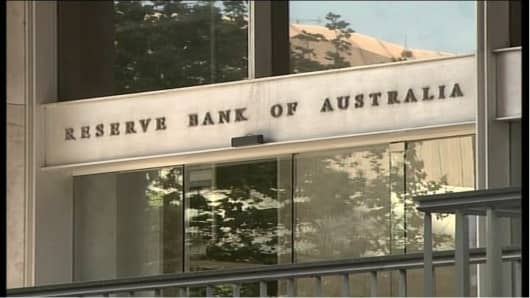Australia's central bank felt there were enough signs of life in the economy to hold off cutting interest rates at its March 5 review even though a benign inflation outlook gave it scope to ease policy, minutes of the meeting showed on Tuesday.
Reserve Bank of Australia (RBA) policy makers thought lending rates were clearly below normal levels and there were signs the economy was responding to stimulus already delivered, a view that has been backed by a run of strong data this month.
"At this meeting, the Board's assessment was that, while further reductions may be required, on the information currently at hand it was appropriate to hold rates steady and to assess further developments over the period ahead," the minutes showed.
(Read More: Australia Employment Soars, Market Gives Up on Rate Cut)
Having cut its cash rate by 175 basis points since late 2011 to a record low 3.0 percent, the RBA has held policy steady so far this year amid evidence that asset prices, consumer sentiment and housing construction were all starting to pick up.
Data this month, notably employment figures for February and retail sales for January, has added to the case that the economy is picking up some momentum, and investors have pretty much unwound expectations for another rate cut.
Markets are pricing in a mere 12 basis points worth of easing over the next 12 months, compared with around 50 basis points early in the year.
Debt markets see only a 10 percent chance of a move at the next meeting in April. This is partly helping to underpin the Australian dollar, which held steady near $1.0400.
"Overall, we continue to get a sense that the RBA remains in wait-and-see mode," said Alvin Pontoh, a strategist at TDSecurities.
"There is some chance that the Bank's easing bias is softened at the next communique, but we don't expect it to be dropped entirely until the Bank is confident enough about the outlook for non-mining investment."
(Read More: Australia Central Bank Says No Information Lost in Cyberattacks)
Non-Mining Hopes
Key for the economy is whether investment outside of the mining sector will strengthen in time to fill any gap left when the mining boom finally peaks, RBA Deputy Governor Philip Lowe said in a speech earlier on Tuesday.
"We cannot know the answer to this question yet. At the moment though, the available evidence does suggest that lower interest rates are doing their work broadly as expected," he said.
The minutes noted that mining investment made a further contribution to growth in the December quarter, but it was approaching a peak.
Board members said data suggested potential for a modest increase in non-mining investment in 2013/14, as well as a moderate pick up in dwelling investment.
"Overall, the staff's assessment remained that GDP growth would be a little below trend this year, with a pick-up after that," the minutes showed.
(Read More: Aussie Mining Loses its Lure for China Investors)
Policymakers were clearly more upbeat about the global outlook, saying conditions were now more positive than they had been for much of 2012 and the risks were more balanced.
They noted that growth in China, Australia's single biggest export market, had stabilized at a sustainable pace and even Japan was showing promising signs.
On the United States, another major export market, the RBA said growth there appeared to have continued at a moderate pace.
However, they said Europe remained vulnerable and still faced significant stability challenges from its fiscal and banking sector problems -- since highlighted by the weekend announcement that Cyprus would impose a levy on bank accounts as part of a 10 billion euro ($13 billion) bailout.
The RBA's Lowe said the plans for a tax threatened the integrity of deposits generally and could lead to runs on banks in other euro zone countries where bailouts might be needed.


